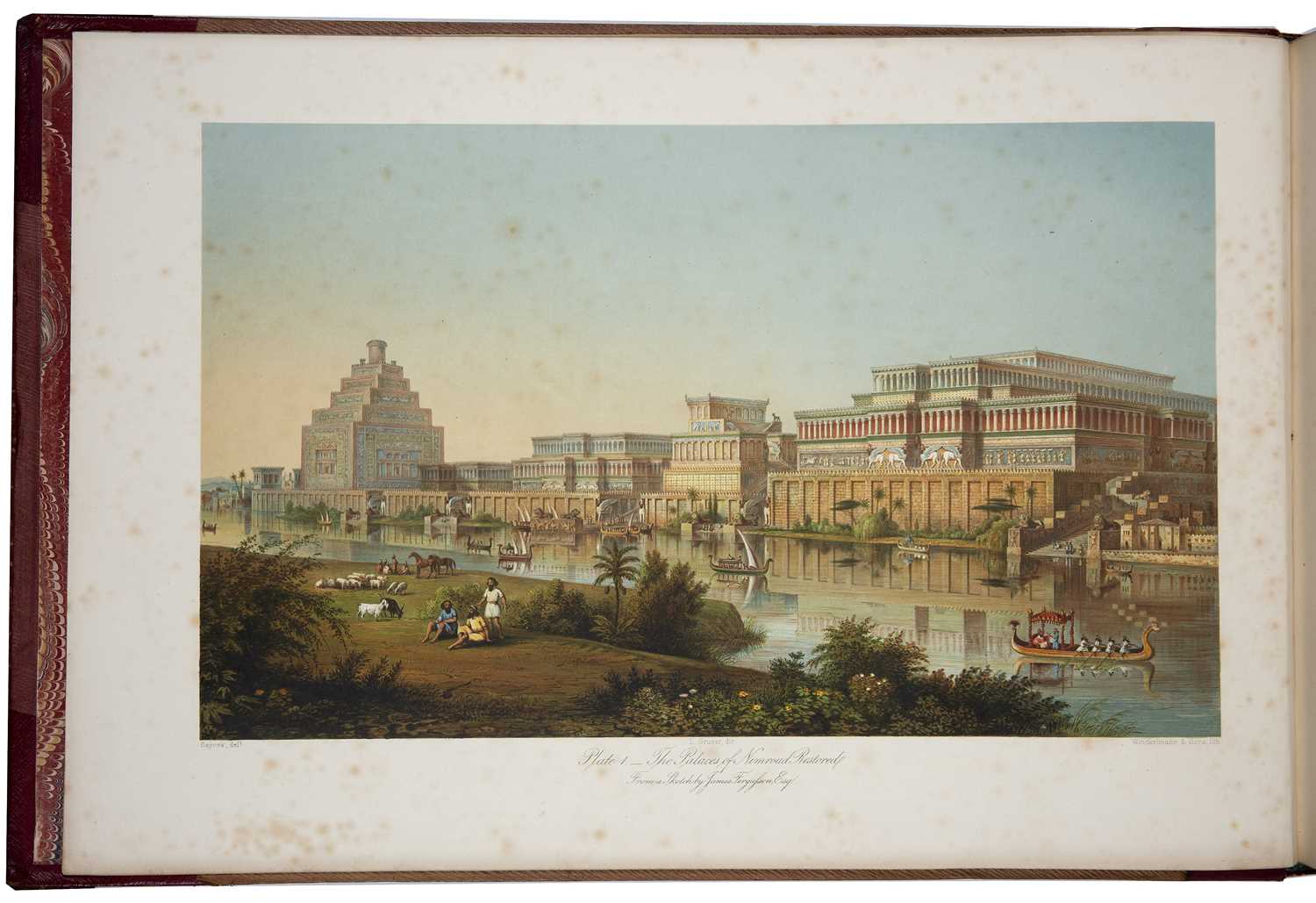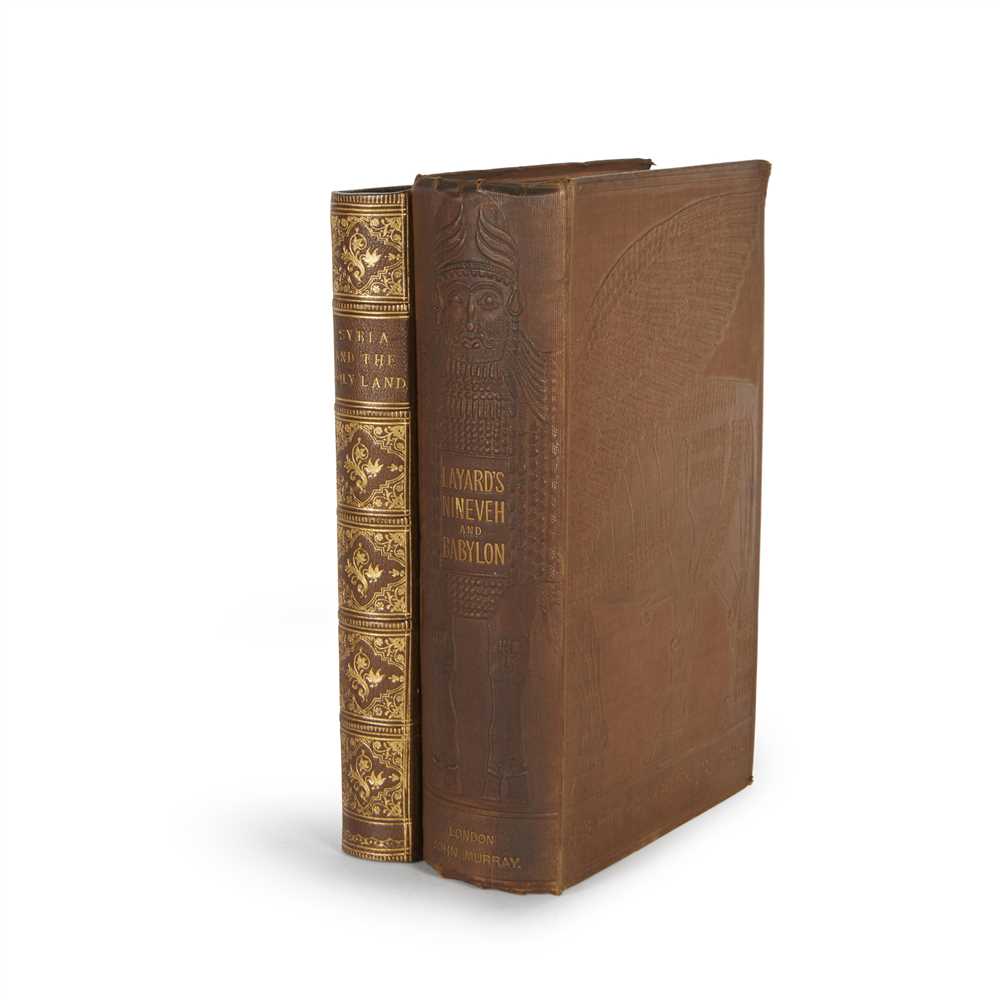LAYARD, Sir Austen Henry (1817-1894). Nineveh and Its Remains with an account of a visit to the Chaldean Christians of Kurdistan, and the Yeziidis, or Devil-Worshippers; and an enquiry into the manners and arts of the ancient Assyrians . London: John Murray 1849. 2 volumes, 8 (240 x 134mm). Half titles, tinted lithographed frontispiece to each volume, 24 plates and plans, some folding and 2 double-page, folding engraved map. (Frontsipieces and double-page plates spotted, occasional spotting elsewhere, errata leaf browned.) Contemporary polished calf, spines gilt with raised bands and contrasting lettering-pieces (extremities rubbed). Provenance : William Philip Earl of Sefton (armorial bookplate). H. A. LAYARD. Discoveries in the Ruins of Nineveh and Babylon with travels in Armenia, Kurdistan and the desert, being the result of a second expedition undertaken for the trustees of the British Museum . London: John Murray 1853. 8 (220 x 137mm). 11 lithographed plates, 2 folding and 8 tinted, and 5 folding maps and plans. Wood-engraved illustrations. (Folding frontispiece and title heavily spotted, lighter spotting in places, folding plan slightly creased.) Original ribbed brown cloth, blind-blocked with a pictorial design and lettered in gilt (spine slightly frayed at foot). Blackmer 969; Abbey Travel 364. FIRST EDITION OF BOTH WORKS. On his first expedition to Mosul (1845-47), Layard was initially financed by Stratford Canning, British ambassador to Constantinople, and later by the British Museum. He wrongly identified the site of the ancient city of Nineveh with the mound at Nimrd, afterwards identified as the ancient Assyrian city of Calah. The bas-reliefs he uncovered there were sawn in half in order to facilitate their transport down the Tigris to Basra, and thence to England. On his second expedition (1849-50), the palaces of Sennacherib and Ashur-bani-pal at Kuyunjik were uncovered. The many cuneiform tablets from the "King's Library" at Kuyunjik were subsequently deciphered by Sir Henry Creswicke Rawlinson, and this led to the site's correct identification as that of ancient Nineveh. Although this identification had first been made by Claudius James Rich in 1820-21, Layward's discoveries, and the crates of Assyrian sculpture he sent back to England, caused a popular sensation. In 1853 he received the freedom of the city of London, while in 1878 he was created a Knight Grand Cross of the Order of the Bath. (3)
LAYARD, Sir Austen Henry (1817-1894). Nineveh and Its Remains with an account of a visit to the Chaldean Christians of Kurdistan, and the Yeziidis, or Devil-Worshippers; and an enquiry into the manners and arts of the ancient Assyrians . London: John Murray 1849. 2 volumes, 8 (240 x 134mm). Half titles, tinted lithographed frontispiece to each volume, 24 plates and plans, some folding and 2 double-page, folding engraved map. (Frontsipieces and double-page plates spotted, occasional spotting elsewhere, errata leaf browned.) Contemporary polished calf, spines gilt with raised bands and contrasting lettering-pieces (extremities rubbed). Provenance : William Philip Earl of Sefton (armorial bookplate). H. A. LAYARD. Discoveries in the Ruins of Nineveh and Babylon with travels in Armenia, Kurdistan and the desert, being the result of a second expedition undertaken for the trustees of the British Museum . London: John Murray 1853. 8 (220 x 137mm). 11 lithographed plates, 2 folding and 8 tinted, and 5 folding maps and plans. Wood-engraved illustrations. (Folding frontispiece and title heavily spotted, lighter spotting in places, folding plan slightly creased.) Original ribbed brown cloth, blind-blocked with a pictorial design and lettered in gilt (spine slightly frayed at foot). Blackmer 969; Abbey Travel 364. FIRST EDITION OF BOTH WORKS. On his first expedition to Mosul (1845-47), Layard was initially financed by Stratford Canning, British ambassador to Constantinople, and later by the British Museum. He wrongly identified the site of the ancient city of Nineveh with the mound at Nimrd, afterwards identified as the ancient Assyrian city of Calah. The bas-reliefs he uncovered there were sawn in half in order to facilitate their transport down the Tigris to Basra, and thence to England. On his second expedition (1849-50), the palaces of Sennacherib and Ashur-bani-pal at Kuyunjik were uncovered. The many cuneiform tablets from the "King's Library" at Kuyunjik were subsequently deciphered by Sir Henry Creswicke Rawlinson, and this led to the site's correct identification as that of ancient Nineveh. Although this identification had first been made by Claudius James Rich in 1820-21, Layward's discoveries, and the crates of Assyrian sculpture he sent back to England, caused a popular sensation. In 1853 he received the freedom of the city of London, while in 1878 he was created a Knight Grand Cross of the Order of the Bath. (3)















Testen Sie LotSearch und seine Premium-Features 7 Tage - ohne Kosten!
Lassen Sie sich automatisch über neue Objekte in kommenden Auktionen benachrichtigen.
Suchauftrag anlegen